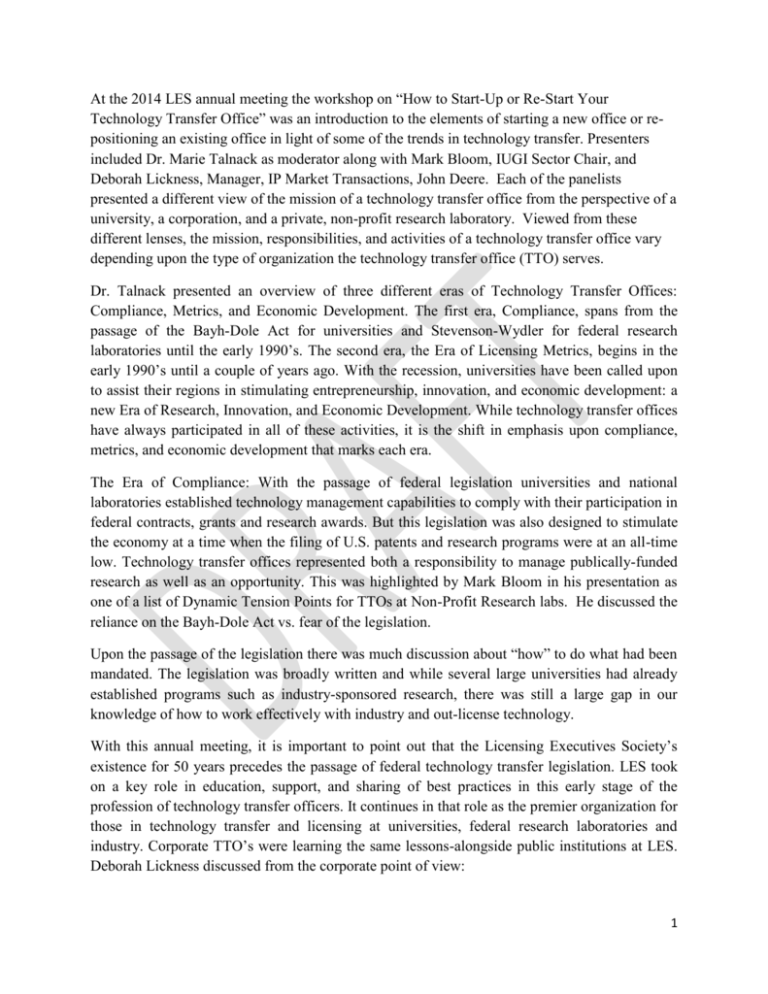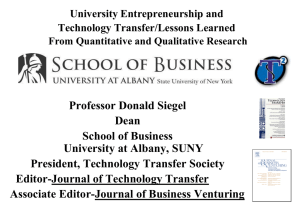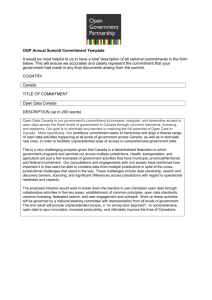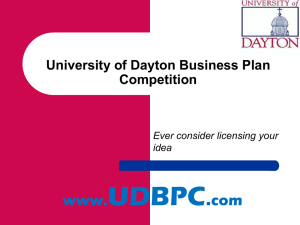DRAFT At the 2014 LES annual meeting the workshop on “How to
advertisement

At the 2014 LES annual meeting the workshop on “How to Start-Up or Re-Start Your Technology Transfer Office” was an introduction to the elements of starting a new office or repositioning an existing office in light of some of the trends in technology transfer. Presenters included Dr. Marie Talnack as moderator along with Mark Bloom, IUGI Sector Chair, and Deborah Lickness, Manager, IP Market Transactions, John Deere. Each of the panelists presented a different view of the mission of a technology transfer office from the perspective of a university, a corporation, and a private, non-profit research laboratory. Viewed from these different lenses, the mission, responsibilities, and activities of a technology transfer office vary depending upon the type of organization the technology transfer office (TTO) serves. Dr. Talnack presented an overview of three different eras of Technology Transfer Offices: Compliance, Metrics, and Economic Development. The first era, Compliance, spans from the passage of the Bayh-Dole Act for universities and Stevenson-Wydler for federal research laboratories until the early 1990’s. The second era, the Era of Licensing Metrics, begins in the early 1990’s until a couple of years ago. With the recession, universities have been called upon to assist their regions in stimulating entrepreneurship, innovation, and economic development: a new Era of Research, Innovation, and Economic Development. While technology transfer offices have always participated in all of these activities, it is the shift in emphasis upon compliance, metrics, and economic development that marks each era. The Era of Compliance: With the passage of federal legislation universities and national laboratories established technology management capabilities to comply with their participation in federal contracts, grants and research awards. But this legislation was also designed to stimulate the economy at a time when the filing of U.S. patents and research programs were at an all-time low. Technology transfer offices represented both a responsibility to manage publically-funded research as well as an opportunity. This was highlighted by Mark Bloom in his presentation as one of a list of Dynamic Tension Points for TTOs at Non-Profit Research labs. He discussed the reliance on the Bayh-Dole Act vs. fear of the legislation. Upon the passage of the legislation there was much discussion about “how” to do what had been mandated. The legislation was broadly written and while several large universities had already established programs such as industry-sponsored research, there was still a large gap in our knowledge of how to work effectively with industry and out-license technology. With this annual meeting, it is important to point out that the Licensing Executives Society’s existence for 50 years precedes the passage of federal technology transfer legislation. LES took on a key role in education, support, and sharing of best practices in this early stage of the profession of technology transfer officers. It continues in that role as the premier organization for those in technology transfer and licensing at universities, federal research laboratories and industry. Corporate TTO’s were learning the same lessons-alongside public institutions at LES. Deborah Lickness discussed from the corporate point of view: 1 -Why would a company think of starting an IP Licensing Department? -What should be considered by an operating company in starting an IP licensing department? -How would such a department be staffed and what would be their responsibilities? Technology Transfer offices were established, best practices institutionalized into university and federal laboratory intellectual property policy, ways of conducting business standardized, and professionals with diverse backgrounds in science, law, and management trained in the practice of licensing. Thus, we entered into the era of metrics. In the Era of Licensing Metrics technology transfer offices were tasked with identifying ‘licensable’ technologies and finding the highest bidder for that asset. Their metrics were simple and straightforward: royalties reported to University Administration to justify the cost of their office operations and offset the cost of research. Lickness shared the metrics for a corporate IP licensing department. Not surprisingly, the main metrics center around licensing revenues as well and a discussion ensued about TTOs covering their operating costs. Bloom discussed this Profit Center vs. Cost Center Model for TTO’s as another Dynamic Tension Point. TTO’s entered into reporting as compliance but also in large part to manage expectations about their efficiency: licenses entered into, completed, annual royalties generated by each institution and ranked by the largest royalty-generating institutions. With licensing royalties institutions found ways to support the construction and maintenance of laboratories, equipment, faculty salaries, graduate students, and industrial parks or accelerators. This began the era of using royalties to not only offset the cost of operating a technology transfer office but using royalties to support research programs and build critical infrastructure. However, the rankings of the technology transfer offices generating the most revenues from licensing showed a great disparity between the top tier research universities and everyone else. Bloom pointed out that another tension is that financial success of TTO’s is driven in equal measure by the skill of the TTO staff and by luck –what he referred to as “random faculty input”. Thus, it is critical that your office manage expectations of stakeholders and understand how long it will take to begin to generate licensing deals. We have recently entered into a new Era of Research, Innovation, and Economic Development. A Grand Challenge as again we are being asked to “do more with less” (Bloom). This new emphasis for universities to participate in regional public-private economic development partnerships results in large part to federal grant opportunities encouraging regional partnerships and innovation clusters. An example provided by the Small Business Administration is the following: “Successful proposals will include partnerships with and between industry, academia, economic development organizations, entrepreneurial education programs, and training initiatives and will reflect an industry-specific focus and collaboration.” But the question 2 remains, what role does the technology transfer office play in these regional economic development initiatives? This workshop introduced a much broader model of the technology transfer office in terms of mission and long-term vision within its parent organization. Today’s Technology Transfer Office is also being tasked with how they can contribute to local economic development. Universities are innovation hubs and corporations are local citizens in regional economic development. This workshop offered information and examples to assist in either setting up a new Technology Transfer Office in this current environment or “Re-Boot” an existing office to transition services, metrics, internal capabilities and staffing to meet the needs of this newest era. Federal agencies are interested in partnerships between key institutions in a region. Partnerships are easier said than done—there are among the players different cultures, agendas, missions, etc. Where do you start? One place is the collaboration on new research which means the university technology transfer office meeting with a corporate technology transfer office about newly emerging technologies and how the “next big thing” (Bloom) can stimulate the local economy. Discussed in the workshop from the point of view of universities, non-profit research labs and corporate TTO’s was that each partner needs to evaluate participation in these new regional economic development partnerships based upon the following: -Roles/Expectations of the Partners -ROI from Different Partner’s Perspectives -Benefits to Each Partner -Deliverables from Each Partner From the various partner’s perspective, there are key differences in motivations, resources, acceptance of risk, time commitment, and end goals for the partnership. However, all of the partners could agree that such initiatives make sense when they offer the following: • opportunities for new areas of research and educational programs • help the institution or company grow • build new partnerships and new levels of relationships • provide a means of funding and sustaining new initiatives. 3






